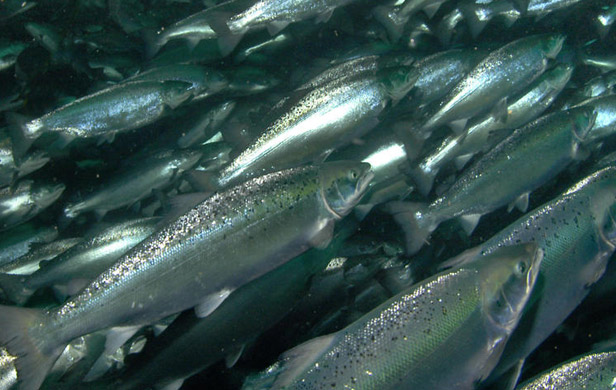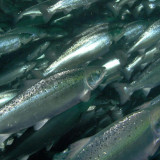
A new study published in ICES Journal of Marine Science estimates that that up to 1.5 million farmed Atlantic salmon escape from Norwegian netpens into the wild every year – far more than acknowledged by the industry.
The study was led by Ove T. Skilbrei of the Institute of Marine Research in Bergen, Norway, assisted by researchers at the University of Bergen and the International Institute for Applied Systems Analysis in Austria.
The risk is that escaped farmed salmon mate with wild fish, impacting survival rates.
After tagging and simulating some 90,000 escapes in various near-shore and marine environments on the coast of Norway at different times throughout 2005, the researchers followed these fish over the next five years, observing how many were recaptured by fishermen.
According to the study:
[quote]Post-smolts that escaped during their first summer were capable of rapid migration towards the open sea. A small fraction returned to spawn and were recaptured after 1–3 years at sea (0.4%, range 0.0–1.1%). A total of 13% of the post-smolts that escaped during autumn were reported in nearby fisheries during subsequent months, partly because they had grown large enough to be caught in the gillnets used, but more importantly because migratory behaviour diminished towards the end of the year. The mean recapture rate of adult salmon was high after releases in fjords (7 – 33%), lower after coastal releases (4 – 7%), and zero on the outer coast. [/quote]
Based on mathematical probabilities for recapturing escaped fish, the researchers predict that up to 1.5 million farmed fish escape from Norwegian farms each year, evading recapture.
“Importantly, our analysis suggests that the total numbers of post-smolt and adult escapees have been two- to fourfold as high as the numbers reported to the authorities by fish farmers,” the study concludes.
According to a 2008 report by the World Wildlife Fund, escapees can be far ranging – “usually recorded within 500 km of the escape site, but [they] have been recorded up to 2,000 – 4,500 km from the escape/release site.”
An earlier study led by UVic scientist Dr. John Volpe, published in Conservation Biology, also reported that escaped Atlantic salmon (the vast majority of farmed salmon in BC are also non-native Atlantics) have been discovered in more than 80 wild salmon spawning streams (Conservation Biology 14: 899-903).
“Farmed salmon grow very fast, are aggressive, and not as clever as wild salmon when it comes to dealing with predators,” says Professor Matt George of the University of East Anglia, who led a study on the subject released earlier this year.
[quote]These domestic traits are good for producing fish for the table, but not for the stability of wild populations…The problem is that farmed salmon can escape each year in their millions, getting into wild spawning populations, where they can then reproduce and erode wild gene pools, introducing these negative traits.[/quote]
In light of these new statistics from Bergen, the problem may be far more serious than perviously thought – and especially cause for concern with embattled wild salmon populations in places like British Columbia.


I know zip-diddle about computers or simulations, and I admit up-front I am predisposed to a negative opinion of the fish feedlot industry, I’ve tried to work against it almost from the get-go. But I would suggest that if we look at everything else the industry has tried to feed us, sometimes trying to cram it down our throats, we have no reason to even begin to believe anything they tell us. Our provincial governments have pampered this industry, at the expense of the wild fish, giving back the fines the courts imposed on the industry, and paying millions every year to NORWAY to recompense them for the morts, the fish which die in the pens. Norwegian companies dominate the industry and they’re here because they can get away with practices they’d never be allowed to do in Norway. We’re being had, and it’s time to invite the industry to either move to proper closed-containment tanks on land, with tertiary sewage treatment, or leave our waters and not come back.
I’m personally convinced that the escape rate for farmed salmon is much higher than the industry will admit to. Still, I am not strongly swayed by the results, mainly because they are based on computer simulations, which I have some experience with. The main take-away from having worked on a simulation project is that the end-result is only as good as the assumptions that you feed into the simulation and these assumptions are often little more than guess-work. Without detailed information on the assumptions used, and how they were justified, you simply can’t tell if these results are realistic.
Partly based on simulations, Ron – but rooted in a decent-sized real world sample of 90,000 fish, tagged and tracked over a 5 year period…so we’re dealing with some pretty solid data.